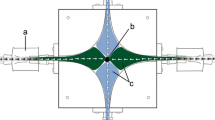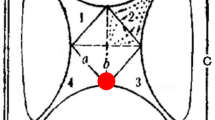Abstract
Controlled infestation ofDendroctonus terebrans (Olivier) on bolts of slash pine,Pinus ellionii Engelm. var.elliottii, elicited greater attraction of wild conspecifics than uninfested bolts. Secondary attraction was not apparent, however, to standing slash pines that had received volunteer attacks, when compared with attraction to unattacked but susceptible trees. Hindguts from in-flight or attacking femaleD. terebrans contained frontalin, and those from in-flight or attacking males containedexo-brevicomin.Trans-pinocarveol,cis-verbenol,trans-verbenol, myrtenal, verbenone, myrtenol, and other compounds were produced by both sexes during gallery construction in host trees. Synthetic frontalin, when deployed with a standard host odor mixture of turpentine and ethanol, was very attractive to maleD. terebrans in field-trapping experiments. The addition of eitherexo-brevicomin orendo-brevicomin to the frontalin-turpentine combination negated the attractive effect of frontalin for males.Trans-verbenol, myrtenol, and verbenone had little effect onD. terebrans behavior. Responses of females did not differ among treatments in any of the 11 field experiments.
Similar content being viewed by others
References
Alcock, J. 1982. Natural selection and communication among bark beetles.Fla. Entomol. 65:17–32.
Billings, R.F. 1985. Southern pine bark beetles and associated insects-effects of rapidly-released host volatiles on response to aggregation pheromones.Z. Angew. Entomol. 99:483–491.
Borden, J.H. 1982. Aggregation pheromones, pp. 74–139,in J.B. Mitton and K.B. Sturgeon (eds.). Bark Beetles in North American Conifers: A System for the Study of Evolutionary Biology. University of Texas Press, Austin.
Borden, J.H., Vandersar, T.J., andStokkink, E. 1975. Secondary attraction in the Scolytidae: An annotated bibliography. Pest Management Paper No. 4. Simon Fraser University, Burnaby, British Columbia. 192 pp.
Borden, J.H., Hunt, D.W.A., Miller, D.R., andSlessor, K.N. 1986. Orientation in forest Coleoptera: An uncertain outcome of responses by individual beetles to variable stimuli, pp. 97–109,in T.L. Payne, M.C. Birch, and C.E.J. Kenedy (eds.). Mechanisms in Insect Olfaction. Oxford University Press, New York.
Brand, J.M., Bracke, J.W., Markovetz, O.J., Wood, D.L., andBrowne, L.E. 1975. Production of verbenol pheromone by a bacterium isolated from bark beetles.Nature 254:136–137.
Conn, J.E., Borden, J.H., Hunt, D.W.A., Holman, J., Whitney, H.S., Spanier, O.J., Pierce, H.D., Jr., andOehlschlager, A.C. 1984. Pheromone production by axenically rearedDendroctonus ponderosae andIps paraconfusus (Coleoptera: Scolytidae).J. Chem. Ecol. 10:281–190.
Fargo, W.S., Coulson, R.N., Pulley, P.E., Pope, D.N., andKellet, C.L. 1978. Spatial and temporal patterns of within-tree colonization byDendroctonus frontalis.Can. Entomol. 110:1213–1232.
Fatzinoer, C.W. 1985. Attraction of the black turpentine beetle (Coleoptera: Scolytidae) and other forest Coleoptera to turpentine-baited traps.Environ. Entomol. 14:768–775.
Fatzinoer, C.W., Siegfried, B.D., Wilkinson, R.C., andNation, J.L. 1987.trans-Verbenol, turpentine, and ethanol as trap baits for the black turpentine beetle,Dendroctonus terebrans and other forest Coleoptera in north Florida.J. Entomol. Sci. 22:201–209.
Godbee, J.F., andFranklin, R.T. 1976. Attraction, attack patterns and seasonal activity of the black turpentine beetle.Ann. Entomol. Soc. Am. 69:653–655.
Hopkins, A.D. 1909. The genusDendroctonus. U.S. Department of Agriculture Bureau of Entomology Technical Series 17, Part 1.
Hughes, P.R. 1973.Dendroctonus: production of pheromones and related compounds in response to host monoterpenes.Z. Angew. Entomol. 73:294–312.
Hughes, P.R. 1975. Pheromones ofDendroctonus: Origin of alpha-pinene oxidation products present in emergent adults.J. Insect Physiol. 21:687–691.
Kowal, R.J., andCoyne, J.F. 1951. The black turpentine beetle can kill trees.Am. Turpentine-Farmers Assoc. J. 13:7, 14–15.
Lanier, G.N. 1983. Integration of visual stimuli, host odorants, and pheromones by bark beetles and weevils in locating and colonizing host trees, pp. 161–171,in S. Ahmad (ed.). Herbivorous Insects. Academic Press, New York.
Lanne, B.S., Schlyter, F., Byers, J.A., Lofqvist, J., Leufven, A., Bergstrom, G., VanDerPers, J.N.C., Unelius, R., Baeckstrom, P., andNorin, T. 1987. Differences in attraction to semiochemicals present in sympatric pine shoot beetles,Tomicus minor andT. piniperda.J. Chem. Ecol. 13:1045–1067.
Merkel, E.P. 1981. Control of the black turpentine beetle. Georgia Forest Research Paper 15. Georgia Forestry Commission.
Millar, J.G., Zhao, C.H., Lanier, G.N., O'Callaghan, D.P., Griggs, M., West, J.R., andSilverstein, R.M. 1986. Components of moribund American elm trees as attractants to elm bark beetles,Hylurgopinus rufipes andScolytus multistriatus.J. Chem. Ecol. 12:583–608.
Mirov, N.T. 1961. Composition of gum turpentines of pines. U.S. Department of Agriculture Technical Bulletin No. 1239.
Payne, T.L., Billings, R.F., Delorme, J.D., Andryszak, N.A., Bartels, J., Franke, W., andVité, J.P. 1987. Kairomonal-pheromonal system in the black turpentine beetle,Dendroctonus terebrans (Ol.)J. Appl. Entomol. 103:15–22.
Phillips, T.W., Wilkening, A.J., Atkinson, T.H., Nation, J.L., Wilkinson, R.C., andFoltz, J.L. 1988. Synergism of turpentine and ethanol as attractants for certain pine-infesting beetles.Environ. Entomol. 17:456–462.
Raffa, K.F., andBerryman, A.A. 1983. The role of host plant resistance in the colonization behavior and ecology of bark beetles (Coleoptera: Scolytidae).Ecol. Monogr. 53:27–49.
Roberts, D.R. 1973. Inducing lightwood in pine trees by paraquat treatment. U.S. Department of Agriculture Forest Service Research Note SE-191.
Siegfried, B.D., Fatzinger, C.W., Wilkinson, R.C., andNation, J.L. 1986. In-flight responses of the black turpentine beetle (Coleoptera: Scolytidae) to individual monoterpenes, turpentine, and paraquat-treated slash pines.Environ. Entomol. 15:710–714.
Smith, R.H. 1963. Preferential attack byDendroctonus terebrans onPinus elliottii.J. Econ. Entomol. 56:817–819.
Smith, R.H., andLee, R.E., III. 1957. Black turpentine beetle. U.S. Forest Service Pest Leaflet 12.
Vité, J.P., Gara, R.I., andvon Scheller, J.D. 1964. Field observations on the response to attractants of bark beetles infesting southern pines.Contrib. Boyce Thompson Inst. 22:461–470.
Vité, J.P., Billings, R.F., Ware, C.W., andMori, K. 1985. Southern pine beetle: Enhancement or inhibition of aggregation response mediated by enantiomer of endo-brevicomin.Naturwissenschaften 72:99–100.
White, R.A., Jr., Agosin, M., Franklin, R.T., andWebb, J.W. 1980. Bark beetle pheromones: Evidence for physiological synthesis mechanisms and their ecological implications.Z. Angew. Entomol. 90:255–274.
Wood, D.L. 1982. The role of pheromones, kairomones, and allomones in the host selection and colonization behavior of bark beetles.Annu. Rev. Entomol. 27:411–446.
Author information
Authors and Affiliations
Rights and permissions
About this article
Cite this article
Phillips, T.W., Nation, J.L., Wilkinson, R.C. et al. Secondary attraction and field activity of beetle-produced volatiles inDendroctonus terebrans . J Chem Ecol 15, 1513–1533 (1989). https://doi.org/10.1007/BF01012380
Received:
Accepted:
Issue Date:
DOI: https://doi.org/10.1007/BF01012380




